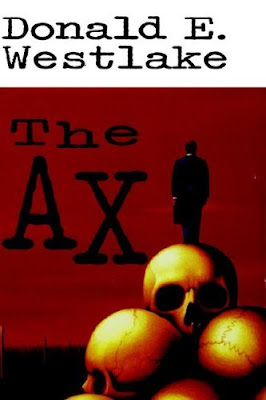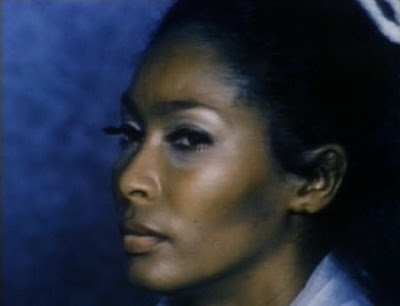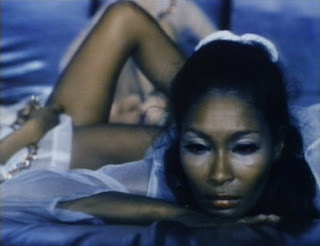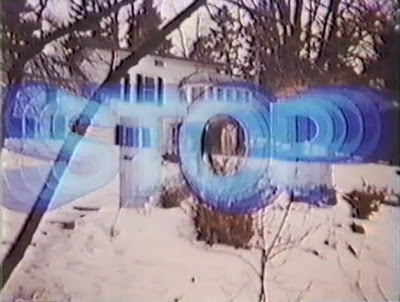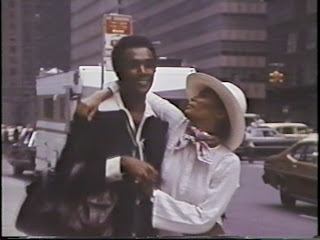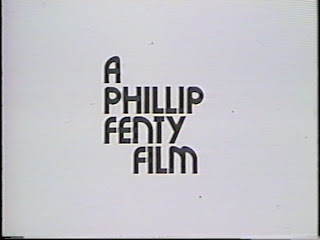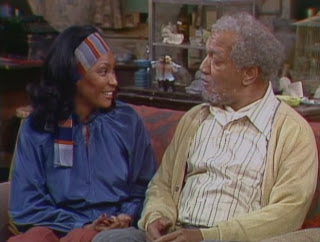Donald E. Westlake was the mad scientist of crime fiction for nearly 50 years, experimenting with style and structure under myriad pen names while creating some of the funniest, darkest and most original examples of the genre. He blessed us with such unforgettable characters as Dortmunder, Mitch Tobin, Parker, Grofield and a host of others. Burke Devore, the homicidal job hunter from his thriller The Ax (Mysterious Press, 1997), isn't in the same league as those others but is still interesting enough to make 273 pages turn quickly.
Two years after being downsized out of his product manager position at a Connecticut paper mill, the still unemployed and increasingly desperate Devore discovers his dream job at a paper processing plant in Arcadia, New York. The catch? Somebody already has the job. But with his morale at an all-time low and tensions mounting at the homestead with every passing day, Devore isn't about to let a minor problem like that stand between him and happily-ever-after. Faster than you can say acid-free archival permanence, our middle-aged family man is unearthing his father's mothballed Luger from WWII and hatching a lunatic scheme to kill off that "fat and happy, smug and secure" production line manager so he can take over the position himself.
But before he does that, Devore needs to eliminate some of his competition. By printing up letterhead stationery for a nonexistent company and placing false want ads in trade journals, he obtains the résumés of other unemployed middle managers in the paper industry. After whittling the pile down to six possible applicants, all of whom have more experience than he has, Devore decides to finish them off as well!
Although the matter-of-fact treatment of a mass murderer going about his grisly business automatically recalls the works of Fredric Brown and Jim Thompson (which Westlake paid homage to in Wax Apple and The Jugger, respectively), The Ax most closely resembles a pastiche of earlier projects by Westlake himself. The story is told in a darkly humorous first-person style reminiscent of Two Much and Enough, but stripped down to the level of the Parker novels he wrote as "Richard Stark," with Devore bearing a striking resemblance to the Jerry Blake character from the Westlake-scripted THE STEPFATHER. Still, the author manages to fit these familiar elements together nicely, creating a satirical thriller that delivers its share of shocks, twists and belly laughs. -- Chris Poggiali
(Fangoria #168, November 1997)
Monday, January 31, 2011
Sunday, January 30, 2011
Movie Ad of the Week: SUPER COLT 38 (1969)
36 year-old American star Nick Adams was originally cast in this Mexican-made western, but died shortly before production began in early 1968. He was replaced by Jeffrey Hunter, who died (at age 42) a few months before the movie opened in New York area Spanish language theaters in September of 1969.
Friday, January 28, 2011
The Endangered List (Case File #95)
THE ASTROLOGER (1975)
Starring
Craig Denney (Alexander)
Darrien Earle (Darrien)
Arthyr Chadbourne (Arthyr)
Florence Marly (Diana Blair)
Rocky Barbanica (Young Alexander)
Harvey Hunter (Prison Officer)
Directed by
Craig Denney
Screenplay by
Dorothy June Pidgeon
Produced by
John William
Executive Producer
Ernest J. Helm
Cinematography by
Allan Gornick, Jr.
Music by
The Moody Blues
("Tuesday Afternoon")
Title theme by
Zubin Mehta
Los Angeles Philharmonic
Filmed in
Astravision
Recorded in
Astrasound
Running time: 96 minutes
MPAA rating: R
Released by
Republic Arts
PLOT: Growing up in a carnival can bring out the worst in a person already inclined to con-games and power trips; certainly Alexander (Craig Denney) is not improved by the experience. Aiding and abetting his development as a most unpleasant fellow is his growing psychic ability. He rises through a number of incredible schemes to a position of power over others, but cannot surmount his own towering ego. - Clarke Fountain, Rovi
Sunday, January 23, 2011
Movie Ad of the Week: THE GAME (1990)
Curtis Brown wrote, produced, directed and starred in THE GAME, which opened at Times Square's Criterion dungeon in April 1990. When we interviewed Terry Levene in December '89, he mentioned that he would be handling the theatrical release of this film, but there was no sign of Aquarius Releasing's involvement four months later when it finally opened. Note the positive review quote from our friend and favorite critic Lawrence Cohn. Did this obscure $500,000 feature even make it to VHS, let alone DVD?
Friday, January 21, 2011
The Endangered List (Case File #94)
TOWING (1978)
Starring
Jennifer Ashley (Jean)
Sue Lyon (Lynn)
Bobby Di Cicco (Tony)
Joe Mantegna (Chris)
J.J. Johnston (Butch)
Audrie J. Neenan (Irate Lady)
Steven Kampmann (Irate Man)
Don DePollo (Pizza Man)
Nan Mason (Nan)
Mike Nusbaum (Phil)
Susanne Smith (Lois)
Jake Stockwell (Tow Truck Driver)
Lee Stein (Mayor)
Sandy Halpin (Waitress)
Bob Wallace (News Reporter)
Joe Brown (Bathroom Man)
and
Dennis Franz
Written and directed
By
Maura Smith
Produced by
Frederick A. Smith
Executive Producers
Alan Gelband
Bob Greenberg
Cinematography by
Hal Schullman
Edited by
Bernard Caputo
Music by
Martin Rubinstein
Sound
Kurt Kreutz
Art Ziemke
Running time: 85 minutes
MPAA rating: PG
from
Sibling Productions
Released by
United International Pictures
Re-released in 1979 as WHO STOLE MY WHEELS?
Re-released in 1981 by Condor Films as FUN GIRLS
Thursday, January 20, 2011
Slinking Through the Seventies: An Interview with Marlene Clark
The following is an expanded and revised interview by Chris Poggiali that originally appeared in Fangoria #191 (April 2000)
It’s hard to believe that actress Marlene Clark’s short but exciting career hasn’t received more attention from fringe movie fanatics. Her résumé boasts leading roles in the legendary GANJA AND HESS, the overlooked LORD SHANGO and such late-night TV staples as NIGHT OF THE COBRA WOMAN and THE BEAST MUST DIE, not to mention supporting parts in cultish favorites like PUTNEY SWOPE, ENTER THE DRAGON and SWITCHBLADE SISTERS.
The talented and stunningly beautiful actress, who has been absent from the screen for nearly 25 years, can think of at least one possible explanation. “I didn’t get a chance to do many interviews,” she says with a laugh, one of many that punctuate her comments. “Most of the movies I starred in didn’t come out when they were supposed to, or never came out at all -- and if the movies aren’t going to be released, the studios aren’t going to do anything to promote them. So you miss out on all that publicity that can lead to other jobs.”
Ironic, considering Clark first reached the public eye as a model for various New York magazines and newspapers during the late 1960s -- “a wonderful time, because more and more opportunities like that were opening up for black women,” she notes. These gigs led to bit parts in late-‘60s filmed like FOR LOVE OF IVY, MIDNIGHT COWBOY, and -- most notably -- PUTNEY SWOPE, Robert Downey’s trailblazing comedy about a black businessman who takes over a stuffy, predominantly white Madison Avenue ad agency.
“That was my first experience with onscreen nudity,” says Clark, who plays a topless stewardess in the film’s Lucky Airlines commercial spoof. “Bob Downey lied to all of us. He said, ‘Take off your tops. You’re out of focus. Nobody will see anything’ -- and we were so stupid, we believed him. Of course, when I saw the movie, I was speechless. Not only was I not out of focus, I couldn’t have been more in focus!” she laughs.
With her sights set on more substantial movie roles, Clark enrolled in Irene Dailey’s School of the Actors Company, continued her dramatic studies with Paul Mann and Stella Adler and appeared on stage in Richard Reich’s PETS, which later became a lurid drive-in movie starring Candice Rialson.
A small part in Hal Ashby’s THE LANDLORD put Clark in contact with its screenwriter, Bill Gunn, a respected stage director/actor/ playwright/novelist who had just signed a deal with Warner Brothers to write and direct his first feature.
“Bill sent me a script he had written called STOP, and asked me if I’d play one of the leads,” she recalls. “It was basically about two married couples who become involved in a four-way. So we went to Puerto Rico for two months and shot the whole thing there. It was beautiful.”
STOP -- which featured cinematography by Owen (THE EXORCIST) Roizman -- received some publicity at the time for being the second major-studio production helmed by an African-American director (after Gordon Parks’ THE LEARNING TREE). The film was slapped with an X rating, heavily re-edited against Gunn’s wishes and eventually shelved by the studio.
“Being involved in a situation like that is extremely frustrating,” Clark says, “because there really is nothing you can do about it. You can’t affect any change or any kind of decisions. So mentally and emotionally, you just have to put it away.”
Despite the disappointment of seeing her first major screen performance confined to a studio vault (where it remains to this day), the New York-born actress relocated to Tinseltown and landed a part in BEWARE! THE BLOB a.k.a. SON OF BLOB (1972), the intentionally silly sequel to the straight-faced 1958 sci-fi schlocker, directed by Larry Hagman.
“Larry’s neighbor [Jack H. Harris] had produced the original BLOB and owned the rights to it,” Clark reveals. “People had talked [to Harris] about doing a sequel, and Larry finally convinced him they should do it together.” [In a ridiculous attempt to cash in on Hagman’s “Who Shot J.R.?” DALLAS cliffhanger, Harris reissued the film in the early ‘80s, advertising it as “The Movie J.R. Shot!”]
Loosely based on A Chip Off the Old Blob, a script Harris had commissioned years earlier, the sequel boasts a cast of familiar faces -- “lots of Larry’s friends,” Clark points out -- including Burgess Meredith, Cindy Williams, Carol Lynley, Dick Van Patten and comedian Godfrey Cambridge, who accidentally unleashes the oozing menace in the opening scene.
“I play Godfrey’s wife, so I’m the first person who dies,” Clark says. “It gets out, kills the cat and then kills me. That was quite an experience. I’d never been consumed by a blob before -- nor have I since!”
BEWARE! THE BLOB may not have steered her career onto the right track, but it certainly put her on the fright track. Later that year, Clark traveled to the Philippines to star in NIGHT OF THE COBRA WOMAN for Roger Corman’s New World Pictures.
Co-written and directed by former Andy Warhol associate Andrew Meyer, the film features Clark as Lena Aruza, a jungle priestess who was bitten by a cobra during WW II and now, years later, needs snake venom and constant sex to stay eternally young. Eventually she transforms into a cobra -- but not before turning several bedmates into exhausted old men after just a few hours of lovemaking!
“When I first read the script, I thought, ‘Whoever wrote this is either gay, or hasn’t had a good time with a woman lately,’” Clark recalls. “You make love [to the cobra woman], and when you wake up, you’re old and you die? What an awful vision of women! I decided that I wasn’t going to think about the Freudian meaning -- I was just gonna take the check and play a woman who turns into a snake.”
Easier said than done, especially when it came to the transformation scenes. “Two hours in the makeup chair,” she groans, “and it was so hot [in the Philippines] that the stuff would immediately start melting and dripping off my face. They were shooting day-for-night, too, so I’d always be in a room with black fabric over the windows, and it would be 95 degrees in there.
“I don’t want to put [the filmmakers] down, but the level of professionalism was not what I was accustomed to,” she continues. “I never would’ve been relaxed around all those snakes anyway, but you certainly don’t feel like you’re being taken care of when the snake handler keeps forgetting to milk the cobras! The director says, ‘OK, we’re ready for the scene where Marlene’s surrounded by snakes.’ I ask the handler, ‘Have you milked the snakes yet? Are you sure they don’t have any venom?’ And he can’t remember! [Laughs] Hello! I’m here with a bunch of snakes!
“The whole thing was strange right from the start. I mean, they brought me to the Philippines to play a Filipino! Now, please, I want somebody to explain this to me, because I’ve never understood that!”
She laughs again, before offering the explanation that “all the Filipino actresses were too smart to walk into a room full of cobras.”
The experience didn’t stop Clark from returning to the Philippines a year and a half later to appear in BLACK MAMBA (1974) for actor-producer John Ashley of THE TWILIGHT PEOPLE and BLACK MAMA, WHITE MAMA infamy.
Clark plays a witch who steals the ring of her deceased lover and then places a voodoo curse on the man's widow, who is being courted by a handsome American doctor (Ashley). Shot back-to-back with the better-known SAVAGE SISTERS, the film remained unreleased until after Ashley's death in 1997. At least one sequence failed to make the final cut, however.
“There’s a scene where I get raped by two dozen midgets,” Clark recalls, "and when they jumped on me, half of them didn’t know they were supposed to be acting. They were all pulling their pants down. I said, ‘Oh no! Whoa! It’s time for me to leave, ‘cause these midgets are really trying to rape me!’ The director said ‘Marlene, wait…’ and started yelling at them, ‘No, this is play! This is pretend!’ I was looking around, like ‘Where’s the plane? Get me on that plane!’”
Closer to home, Clark kept herself busy with guest appearances on BONANZA, THE BILL COSBY SHOW, THE IMMORTAL, MARCUS WELBY M.D., THE ROOKIES, MCCLOUD and several episodes of THE MOD SQUAD, and turned in solid supporting performances in early-‘70s crime thrillers like CLAY PIGEON, SLAUGHTER (pictured above and below), NEWMAN’S LAW and the made-for-TV movie INCIDENT ON A DARK STREET.
She also had a small but memorable role as John Saxon’s secretary in the 1973 kung fu trendsetter ENTER THE DRAGON, wearing one of the coolest-looking hats in the history of chopsocky cinema.
“That’s my Big Apple hat!” Clark says proudly. “I brought a bunch of stuff with me to the set -- I’m a hat person anyway -- and when I pulled out that Big Apple, everyone said, ‘Yes! Put it on!’”
When reminded that the Bruce Lee classic recently celebrated its 25th anniversary, Clark laughs, “I know, and I’m still getting checks for it -- for like $2! I’m not making this up! Four or five times a year, I get a check in the mail for $2. I try not to spend it all in one place.”
Much has been written about the damage inflicted upon GANJA AND HESS (1973), the fascinating, barely released vampire film that reunited the late writer-director Bill Gunn and actress Marlene Clark three years after Warner Brothers shelved their first collaboration, the x-rated erotic thriller STOP.
“I loved working with Bill because he was so imaginative, creative and totally committed to the material,” Clark says. “GANJA AND HESS was his dream, his vision, and there wasn’t a thing he wouldn’t do to make it work. And in the process, he brought people together. Film crews had been traditionally all-white, yet here was a crew that was totally mixed -- and their devotion to Bill, and to what he was trying to say, was really quite impressive.”
 Also impressive were the challenging roles Gunn wrote for Clark and her co-star, the late Duane Jones (from NIGHT OF THE LIVING DEAD). "You couldn’t wish for a better character,” the actress says of Ganja Meda, the mysterious woman who shares the curse of immortality and the thirst for human blood with Jones’ Dr. Hess Green. “There are so many levels to her personality. She’s such a collection of contradictions. Playing that part was very rewarding. And Duane was a treat to work with. He did a terrific job.”
Also impressive were the challenging roles Gunn wrote for Clark and her co-star, the late Duane Jones (from NIGHT OF THE LIVING DEAD). "You couldn’t wish for a better character,” the actress says of Ganja Meda, the mysterious woman who shares the curse of immortality and the thirst for human blood with Jones’ Dr. Hess Green. “There are so many levels to her personality. She’s such a collection of contradictions. Playing that part was very rewarding. And Duane was a treat to work with. He did a terrific job.”
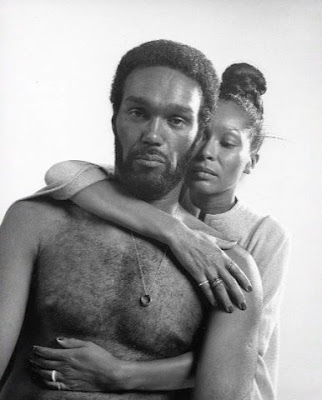 GANJA AND HESS was the only American film screened during Critic’s Week at the 1973 Cannes Film Festival, where it was named one of the 10 Best American Film of the Decade. It opened at Manhattan’s Playboy Theater a few weeks later. “The first time I saw the movie was at the opening-night screening in New York,” Clark reveals. “There was a splashy party afterward -- and being the lead actress, I was pretty much the star of the party! Nothing like that had ever happened to me before. It was wonderful.” The bubble burst the next day, however, when almost every New York critic panned the film. “When I read the reviews, I thought, ‘They didn’t get it,’” Clark remembers. “Many critics believe that black people make very straightforward, literal movies -- so Bill was really an enigma to them. They just did not understand what he had done.”
GANJA AND HESS was the only American film screened during Critic’s Week at the 1973 Cannes Film Festival, where it was named one of the 10 Best American Film of the Decade. It opened at Manhattan’s Playboy Theater a few weeks later. “The first time I saw the movie was at the opening-night screening in New York,” Clark reveals. “There was a splashy party afterward -- and being the lead actress, I was pretty much the star of the party! Nothing like that had ever happened to me before. It was wonderful.” The bubble burst the next day, however, when almost every New York critic panned the film. “When I read the reviews, I thought, ‘They didn’t get it,’” Clark remembers. “Many critics believe that black people make very straightforward, literal movies -- so Bill was really an enigma to them. They just did not understand what he had done.”
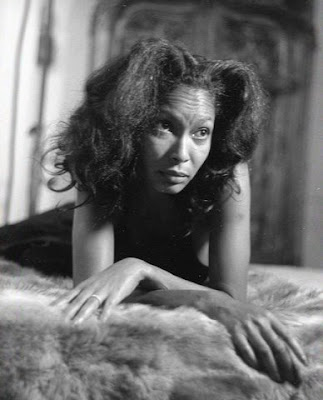 Gunn’s unique cinematic treatment of African-American spirituality and vampirism was also lost on the film’s distributor, Kelly-Jordan Enterprises. After a one-week run in Manhattan, the 110-minute version was pulled from circulation and replaced by a 76-minute bastardization called BLOOD COUPLE, with new credits listing “E.H. Novikov” (a pseudonym for film doctor Fima Noveck) as director.
Gunn’s unique cinematic treatment of African-American spirituality and vampirism was also lost on the film’s distributor, Kelly-Jordan Enterprises. After a one-week run in Manhattan, the 110-minute version was pulled from circulation and replaced by a 76-minute bastardization called BLOOD COUPLE, with new credits listing “E.H. Novikov” (a pseudonym for film doctor Fima Noveck) as director.
For nearly 25 years, it was this version that viewers were subjected to, both in theaters and on video, under such misleading titles as DOUBLE POSSESSION, BLACK EVIL, BLACK VAMPIRE, and BLACKOUT: THE MOMENT OF TERROR.
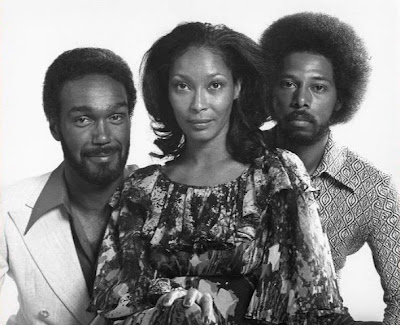 "It never found much of an audience," Clark says, "but a number of industry people saw it, especially in New York, so I was offered some other movies."
"It never found much of an audience," Clark says, "but a number of industry people saw it, especially in New York, so I was offered some other movies."
One of those was THE BEAST MUST DIE, an entertaining chiller from Britain's Amicus Productions. The 1974 film stars Calvin (COTTON COMES TO HARLEM) Lockhart as a wealthy big-game hunter who invites six people to his mansion during a full moon, convinced that one of them is a werewolf. Viewers are allowed to guess who the lycanthrope is during a 30-second "Werewolf Break" near the movie's end.
"I was in London for six weeks on that film," Clark says, "and it was a great time. They treat actors very differently in England. They have enormous respect for them. Even the chairs for the extras have 'artist' printed on the back!"
Coming face to face with one of horror cinema's true legends proved to be even more uplifting. "The first day I was on the set, Peter Cushing came over to me, and he was holding something behind his back," she remembers. "It was a nosegay! He gave me a nosegay to welcome me to the film, and to England. It was such a wonderful gesture. He really was a gentleman."
After hearing that THE BEAST MUST DIE is now available on video as BLACK WEREWOLF, Clark sighs, "Nothing I'm in ever stays the same. My movies are re-titled, re-edited, re-released -- people get into fights, they take their names off the credits... It just goes on and on and on."
Her next genre offering, LORD SHANGO (1975), continued the unfortunate trend. Misleadingly advertised as a voodoo spin on THE EXORCIST, this strange, often confusing supernatural tale -- with a plot involving possession, sacrificial rituals and the conflict between African tribal roots and the Southern Baptist tradition -- left audiences scratching their heads.
Still, the movie received a few favorable reviews from critics intrigued by its depiction of the Yoruba religion, first-hand knowledge of which came courtesy of the film's technical advisor. "Oh my God!" Clark exclaims, "I don't know how they found that man! He was an ex-pimp from Harlem who had bought some property in South Carolina and established an African village. He had like five wives -- of course, being an African king, you get to have all the queens, right? And this was the guy the producers hired to tell them about the Yoruba religion!"
"We all stayed in the same motel," she continues. "He was in one room, his wives were in another, and he would call for whichever wife he wanted that particular evening. I remember thinking, 'This isn't a big leap from being a pimp in New York, except you get to wear a lot of nice robes!'"
After LORD SHANGO bombed in several cities, Bryanston Releasing changed the title to SOULMATES OF SHANGO and dumped it into drive-ins and urban action theaters on the bottom half of a double bill with GHETTO WARRIORS (a.k.a. THE BLACK GESTAPO). The film sank without a trace until a few years ago, when Xenon Entertainment released it on video as THE COLOR OF LOVE.
Clark herself has never seen LORD SHANGO, and when told that her performance is quite good, she says, "Well, I'm glad, because I had a tough time keeping a straight face through most of it! Every night after we finished shooting, I'd go back to my room, bury my face in a pillow and just laugh my head off. I couldn't believe what was going on around me."
SWITCHBLADE SISTERS (1975), Jack Hill's wild girl-gang rendition of Shakespeare's Othello, came next. Originally released as THE JEZEBELS, the incomparable drive-in favorite features Clark in the role of Muff, the leader of an all-female black revolutionary organization that joins forces with the titular gang to rub out a bunch of murderous drug dealers.
"It wasn't a very big part," she admits, "but it was fun to play. I had a copy of Mao Tse-tung's Red Book stuck in my jacket pocket, and I had the best time."
That is, until she found herself in the middle of a blazing shootout, firing a machine gun from atop a modified car/tank that crushes a rival gang member against a brick wall.
"That wasn't handled well at all," Clark says of the setpiece that nearly sent her to the emergency room. "The guy who was supposed to be the stunt coordinator was really just a stuntman. He didn't put me in a special jacket or brace or anything. I had no support whatsoever -- and when that thing drove up onto the sidewalk and hit the wall, my ribs just shook all over the inside of my body. I really thought something was broken." She pauses for a moment, then adds, "I always thought one of the best things about acting was that you got to do all the stuff that other people get hospitalized for!"
Although the movie was a box-office flop under both titles, it was reissued in 1981 by Motion Picture Marketing as PLAYGIRL GANG, and later gained a following on video.
Quentin Tarantino, a longtime fan of Hill's work, bought the rights and rereleased the film in 1996 through his Rolling Thunder Pictures -- an event that called for a celebration.
"My commercial agency called me and said, 'We have an envelope for you' -- it was an invitation to a screening of SWITCHBLADE SISTERS!" Clark laughs. "[Rolling Thunder] actually sent a car to bring me to the screening! All the way over I thought, 'This is a flashback -- I'm having a breakdown.' Nope! I got to the theater, and it was for real! All the other women from the movie were there, and there was a nice little party afterward at a place called the Red Room. It was amazing."
In 1976, Clark reunited with BEAST MUST DIE's Lockhard (as well as GANJA AND HESS producer Chiz Schultz) for BARON WOLFGANG VON TRIPPS, the story of an actor who runs afoul of mobsters and drug dealers while raising money to complete a film he's directing. The indie production was written and directed by SUPERFLY creator Phillip Fenty.
"That's another film that, for whatever reason, was never released," Clark says. "But I spoke [with Fenty] some years back, and he told me that somebody had bought it. They stumbled across it in a warehouse or something, and put it out on video. I guess it's around, but I haven't seen it." Fenty's film received sparse theatrical exposure in December 1979 through Movietime Films and was released on VHS by Paragon Video in the mid-'80s as THE BARON.
The TV show SANFORD AND SON was still a hit when Clark joined the cast during fall 1976. As Janet Lawson, the fiancee of Lamont Sanford (Demond Wilson), the actress received her widest exposure to date, as well as a rare opportunity to exercise her comedic skills.
"That was so much fun," she says of her one-season stint on the popular sitcom. "I mean, how could you be around Redd Foxx and not have fun? He had us laughing all the time."
More TV appearances followed -- WHAT'S HAPPENING!! and BARNABY JONES among them -- but by then it was the early 1980s, quality roles for black actresses were few and far between and colorblind casting was still years away from even partial acceptance in Hollywood. "That's when it ended for me," Clark says. "The parts dried up, and I didn't do much after that. There just wasn't anything to go out for anymore."
It was around this time that Clark -- who once described herself to Black Stars magazine as "a lady who can't picture herself being anything other than an actress" -- decided to turn her back on Hollywood and direct her energies elsewhere. Today, she's the manager of a successful restaurant in Los Angeles; even though she's still a member of the Screen Actors Guild, she rarely auditions for anything other than commercials. "I can't pursue it anymore," she says flatly. "That part of my life is over now, and the best thing for me to do is leave it that way. Otherwise, I'd just be out there chasing my tail."
However, she did participate in All Day Entertainment's restoration of GANJA AND HESS, recording a DVD audio commentary track with Schultz, cinematographer James E. Hinton and composer Sam Waymon. "After the SWITCHBLADE SISTERS reunion, I thought, 'What next? What other movie are they going to pull out?'" she says. "And sure enough, I got a call -- 'We're putting your movie out on DVD!' It's a terrific film, and I'm glad it's out there again, the way Bill intended it."
Summing up her experiences as an actress, Clark says, "I had a career that I enjoyed -- and I was lucky, because a lot of actresses never get as far as I did. I had leading parts in a number of films, I did quite a few TV shows, and I got to see some interesting places -- London, Puerto Rico, Mexico City..." She pauses for a moment, then adds, "I never made a movie in Paris, though. Some actresses get to go to Paris. Me, I went to Manila -- twice."
She laughs again. "But it's not over yet, right? Who knows -- maybe someday, I'll wind up in a great place."
For more on Marlene, check out her Q&A with Steve Ryfle in issue #39 of Shock Cinema, and don't miss her on-camera interview in the upcoming documentary MACHETE MAIDENS UNLEASHED!
Big thanks to Steve Ryfle, David Kalat, and Howard S. Berger
It’s hard to believe that actress Marlene Clark’s short but exciting career hasn’t received more attention from fringe movie fanatics. Her résumé boasts leading roles in the legendary GANJA AND HESS, the overlooked LORD SHANGO and such late-night TV staples as NIGHT OF THE COBRA WOMAN and THE BEAST MUST DIE, not to mention supporting parts in cultish favorites like PUTNEY SWOPE, ENTER THE DRAGON and SWITCHBLADE SISTERS.
The talented and stunningly beautiful actress, who has been absent from the screen for nearly 25 years, can think of at least one possible explanation. “I didn’t get a chance to do many interviews,” she says with a laugh, one of many that punctuate her comments. “Most of the movies I starred in didn’t come out when they were supposed to, or never came out at all -- and if the movies aren’t going to be released, the studios aren’t going to do anything to promote them. So you miss out on all that publicity that can lead to other jobs.”
Ironic, considering Clark first reached the public eye as a model for various New York magazines and newspapers during the late 1960s -- “a wonderful time, because more and more opportunities like that were opening up for black women,” she notes. These gigs led to bit parts in late-‘60s filmed like FOR LOVE OF IVY, MIDNIGHT COWBOY, and -- most notably -- PUTNEY SWOPE, Robert Downey’s trailblazing comedy about a black businessman who takes over a stuffy, predominantly white Madison Avenue ad agency.
“That was my first experience with onscreen nudity,” says Clark, who plays a topless stewardess in the film’s Lucky Airlines commercial spoof. “Bob Downey lied to all of us. He said, ‘Take off your tops. You’re out of focus. Nobody will see anything’ -- and we were so stupid, we believed him. Of course, when I saw the movie, I was speechless. Not only was I not out of focus, I couldn’t have been more in focus!” she laughs.
With her sights set on more substantial movie roles, Clark enrolled in Irene Dailey’s School of the Actors Company, continued her dramatic studies with Paul Mann and Stella Adler and appeared on stage in Richard Reich’s PETS, which later became a lurid drive-in movie starring Candice Rialson.
A small part in Hal Ashby’s THE LANDLORD put Clark in contact with its screenwriter, Bill Gunn, a respected stage director/actor/ playwright/novelist who had just signed a deal with Warner Brothers to write and direct his first feature.
“Bill sent me a script he had written called STOP, and asked me if I’d play one of the leads,” she recalls. “It was basically about two married couples who become involved in a four-way. So we went to Puerto Rico for two months and shot the whole thing there. It was beautiful.”
STOP -- which featured cinematography by Owen (THE EXORCIST) Roizman -- received some publicity at the time for being the second major-studio production helmed by an African-American director (after Gordon Parks’ THE LEARNING TREE). The film was slapped with an X rating, heavily re-edited against Gunn’s wishes and eventually shelved by the studio.
“Being involved in a situation like that is extremely frustrating,” Clark says, “because there really is nothing you can do about it. You can’t affect any change or any kind of decisions. So mentally and emotionally, you just have to put it away.”
Despite the disappointment of seeing her first major screen performance confined to a studio vault (where it remains to this day), the New York-born actress relocated to Tinseltown and landed a part in BEWARE! THE BLOB a.k.a. SON OF BLOB (1972), the intentionally silly sequel to the straight-faced 1958 sci-fi schlocker, directed by Larry Hagman.
“Larry’s neighbor [Jack H. Harris] had produced the original BLOB and owned the rights to it,” Clark reveals. “People had talked [to Harris] about doing a sequel, and Larry finally convinced him they should do it together.” [In a ridiculous attempt to cash in on Hagman’s “Who Shot J.R.?” DALLAS cliffhanger, Harris reissued the film in the early ‘80s, advertising it as “The Movie J.R. Shot!”]
Loosely based on A Chip Off the Old Blob, a script Harris had commissioned years earlier, the sequel boasts a cast of familiar faces -- “lots of Larry’s friends,” Clark points out -- including Burgess Meredith, Cindy Williams, Carol Lynley, Dick Van Patten and comedian Godfrey Cambridge, who accidentally unleashes the oozing menace in the opening scene.
“I play Godfrey’s wife, so I’m the first person who dies,” Clark says. “It gets out, kills the cat and then kills me. That was quite an experience. I’d never been consumed by a blob before -- nor have I since!”
BEWARE! THE BLOB may not have steered her career onto the right track, but it certainly put her on the fright track. Later that year, Clark traveled to the Philippines to star in NIGHT OF THE COBRA WOMAN for Roger Corman’s New World Pictures.
Co-written and directed by former Andy Warhol associate Andrew Meyer, the film features Clark as Lena Aruza, a jungle priestess who was bitten by a cobra during WW II and now, years later, needs snake venom and constant sex to stay eternally young. Eventually she transforms into a cobra -- but not before turning several bedmates into exhausted old men after just a few hours of lovemaking!
“When I first read the script, I thought, ‘Whoever wrote this is either gay, or hasn’t had a good time with a woman lately,’” Clark recalls. “You make love [to the cobra woman], and when you wake up, you’re old and you die? What an awful vision of women! I decided that I wasn’t going to think about the Freudian meaning -- I was just gonna take the check and play a woman who turns into a snake.”
Easier said than done, especially when it came to the transformation scenes. “Two hours in the makeup chair,” she groans, “and it was so hot [in the Philippines] that the stuff would immediately start melting and dripping off my face. They were shooting day-for-night, too, so I’d always be in a room with black fabric over the windows, and it would be 95 degrees in there.
“I don’t want to put [the filmmakers] down, but the level of professionalism was not what I was accustomed to,” she continues. “I never would’ve been relaxed around all those snakes anyway, but you certainly don’t feel like you’re being taken care of when the snake handler keeps forgetting to milk the cobras! The director says, ‘OK, we’re ready for the scene where Marlene’s surrounded by snakes.’ I ask the handler, ‘Have you milked the snakes yet? Are you sure they don’t have any venom?’ And he can’t remember! [Laughs] Hello! I’m here with a bunch of snakes!
“The whole thing was strange right from the start. I mean, they brought me to the Philippines to play a Filipino! Now, please, I want somebody to explain this to me, because I’ve never understood that!”
She laughs again, before offering the explanation that “all the Filipino actresses were too smart to walk into a room full of cobras.”
The experience didn’t stop Clark from returning to the Philippines a year and a half later to appear in BLACK MAMBA (1974) for actor-producer John Ashley of THE TWILIGHT PEOPLE and BLACK MAMA, WHITE MAMA infamy.
Clark plays a witch who steals the ring of her deceased lover and then places a voodoo curse on the man's widow, who is being courted by a handsome American doctor (Ashley). Shot back-to-back with the better-known SAVAGE SISTERS, the film remained unreleased until after Ashley's death in 1997. At least one sequence failed to make the final cut, however.
“There’s a scene where I get raped by two dozen midgets,” Clark recalls, "and when they jumped on me, half of them didn’t know they were supposed to be acting. They were all pulling their pants down. I said, ‘Oh no! Whoa! It’s time for me to leave, ‘cause these midgets are really trying to rape me!’ The director said ‘Marlene, wait…’ and started yelling at them, ‘No, this is play! This is pretend!’ I was looking around, like ‘Where’s the plane? Get me on that plane!’”
Closer to home, Clark kept herself busy with guest appearances on BONANZA, THE BILL COSBY SHOW, THE IMMORTAL, MARCUS WELBY M.D., THE ROOKIES, MCCLOUD and several episodes of THE MOD SQUAD, and turned in solid supporting performances in early-‘70s crime thrillers like CLAY PIGEON, SLAUGHTER (pictured above and below), NEWMAN’S LAW and the made-for-TV movie INCIDENT ON A DARK STREET.
She also had a small but memorable role as John Saxon’s secretary in the 1973 kung fu trendsetter ENTER THE DRAGON, wearing one of the coolest-looking hats in the history of chopsocky cinema.
“That’s my Big Apple hat!” Clark says proudly. “I brought a bunch of stuff with me to the set -- I’m a hat person anyway -- and when I pulled out that Big Apple, everyone said, ‘Yes! Put it on!’”
When reminded that the Bruce Lee classic recently celebrated its 25th anniversary, Clark laughs, “I know, and I’m still getting checks for it -- for like $2! I’m not making this up! Four or five times a year, I get a check in the mail for $2. I try not to spend it all in one place.”
Much has been written about the damage inflicted upon GANJA AND HESS (1973), the fascinating, barely released vampire film that reunited the late writer-director Bill Gunn and actress Marlene Clark three years after Warner Brothers shelved their first collaboration, the x-rated erotic thriller STOP.
“I loved working with Bill because he was so imaginative, creative and totally committed to the material,” Clark says. “GANJA AND HESS was his dream, his vision, and there wasn’t a thing he wouldn’t do to make it work. And in the process, he brought people together. Film crews had been traditionally all-white, yet here was a crew that was totally mixed -- and their devotion to Bill, and to what he was trying to say, was really quite impressive.”
 Also impressive were the challenging roles Gunn wrote for Clark and her co-star, the late Duane Jones (from NIGHT OF THE LIVING DEAD). "You couldn’t wish for a better character,” the actress says of Ganja Meda, the mysterious woman who shares the curse of immortality and the thirst for human blood with Jones’ Dr. Hess Green. “There are so many levels to her personality. She’s such a collection of contradictions. Playing that part was very rewarding. And Duane was a treat to work with. He did a terrific job.”
Also impressive were the challenging roles Gunn wrote for Clark and her co-star, the late Duane Jones (from NIGHT OF THE LIVING DEAD). "You couldn’t wish for a better character,” the actress says of Ganja Meda, the mysterious woman who shares the curse of immortality and the thirst for human blood with Jones’ Dr. Hess Green. “There are so many levels to her personality. She’s such a collection of contradictions. Playing that part was very rewarding. And Duane was a treat to work with. He did a terrific job.” GANJA AND HESS was the only American film screened during Critic’s Week at the 1973 Cannes Film Festival, where it was named one of the 10 Best American Film of the Decade. It opened at Manhattan’s Playboy Theater a few weeks later. “The first time I saw the movie was at the opening-night screening in New York,” Clark reveals. “There was a splashy party afterward -- and being the lead actress, I was pretty much the star of the party! Nothing like that had ever happened to me before. It was wonderful.” The bubble burst the next day, however, when almost every New York critic panned the film. “When I read the reviews, I thought, ‘They didn’t get it,’” Clark remembers. “Many critics believe that black people make very straightforward, literal movies -- so Bill was really an enigma to them. They just did not understand what he had done.”
GANJA AND HESS was the only American film screened during Critic’s Week at the 1973 Cannes Film Festival, where it was named one of the 10 Best American Film of the Decade. It opened at Manhattan’s Playboy Theater a few weeks later. “The first time I saw the movie was at the opening-night screening in New York,” Clark reveals. “There was a splashy party afterward -- and being the lead actress, I was pretty much the star of the party! Nothing like that had ever happened to me before. It was wonderful.” The bubble burst the next day, however, when almost every New York critic panned the film. “When I read the reviews, I thought, ‘They didn’t get it,’” Clark remembers. “Many critics believe that black people make very straightforward, literal movies -- so Bill was really an enigma to them. They just did not understand what he had done.” Gunn’s unique cinematic treatment of African-American spirituality and vampirism was also lost on the film’s distributor, Kelly-Jordan Enterprises. After a one-week run in Manhattan, the 110-minute version was pulled from circulation and replaced by a 76-minute bastardization called BLOOD COUPLE, with new credits listing “E.H. Novikov” (a pseudonym for film doctor Fima Noveck) as director.
Gunn’s unique cinematic treatment of African-American spirituality and vampirism was also lost on the film’s distributor, Kelly-Jordan Enterprises. After a one-week run in Manhattan, the 110-minute version was pulled from circulation and replaced by a 76-minute bastardization called BLOOD COUPLE, with new credits listing “E.H. Novikov” (a pseudonym for film doctor Fima Noveck) as director.For nearly 25 years, it was this version that viewers were subjected to, both in theaters and on video, under such misleading titles as DOUBLE POSSESSION, BLACK EVIL, BLACK VAMPIRE, and BLACKOUT: THE MOMENT OF TERROR.
 "It never found much of an audience," Clark says, "but a number of industry people saw it, especially in New York, so I was offered some other movies."
"It never found much of an audience," Clark says, "but a number of industry people saw it, especially in New York, so I was offered some other movies."One of those was THE BEAST MUST DIE, an entertaining chiller from Britain's Amicus Productions. The 1974 film stars Calvin (COTTON COMES TO HARLEM) Lockhart as a wealthy big-game hunter who invites six people to his mansion during a full moon, convinced that one of them is a werewolf. Viewers are allowed to guess who the lycanthrope is during a 30-second "Werewolf Break" near the movie's end.
"I was in London for six weeks on that film," Clark says, "and it was a great time. They treat actors very differently in England. They have enormous respect for them. Even the chairs for the extras have 'artist' printed on the back!"
Coming face to face with one of horror cinema's true legends proved to be even more uplifting. "The first day I was on the set, Peter Cushing came over to me, and he was holding something behind his back," she remembers. "It was a nosegay! He gave me a nosegay to welcome me to the film, and to England. It was such a wonderful gesture. He really was a gentleman."
After hearing that THE BEAST MUST DIE is now available on video as BLACK WEREWOLF, Clark sighs, "Nothing I'm in ever stays the same. My movies are re-titled, re-edited, re-released -- people get into fights, they take their names off the credits... It just goes on and on and on."
Her next genre offering, LORD SHANGO (1975), continued the unfortunate trend. Misleadingly advertised as a voodoo spin on THE EXORCIST, this strange, often confusing supernatural tale -- with a plot involving possession, sacrificial rituals and the conflict between African tribal roots and the Southern Baptist tradition -- left audiences scratching their heads.
Still, the movie received a few favorable reviews from critics intrigued by its depiction of the Yoruba religion, first-hand knowledge of which came courtesy of the film's technical advisor. "Oh my God!" Clark exclaims, "I don't know how they found that man! He was an ex-pimp from Harlem who had bought some property in South Carolina and established an African village. He had like five wives -- of course, being an African king, you get to have all the queens, right? And this was the guy the producers hired to tell them about the Yoruba religion!"
"We all stayed in the same motel," she continues. "He was in one room, his wives were in another, and he would call for whichever wife he wanted that particular evening. I remember thinking, 'This isn't a big leap from being a pimp in New York, except you get to wear a lot of nice robes!'"
After LORD SHANGO bombed in several cities, Bryanston Releasing changed the title to SOULMATES OF SHANGO and dumped it into drive-ins and urban action theaters on the bottom half of a double bill with GHETTO WARRIORS (a.k.a. THE BLACK GESTAPO). The film sank without a trace until a few years ago, when Xenon Entertainment released it on video as THE COLOR OF LOVE.
Clark herself has never seen LORD SHANGO, and when told that her performance is quite good, she says, "Well, I'm glad, because I had a tough time keeping a straight face through most of it! Every night after we finished shooting, I'd go back to my room, bury my face in a pillow and just laugh my head off. I couldn't believe what was going on around me."
SWITCHBLADE SISTERS (1975), Jack Hill's wild girl-gang rendition of Shakespeare's Othello, came next. Originally released as THE JEZEBELS, the incomparable drive-in favorite features Clark in the role of Muff, the leader of an all-female black revolutionary organization that joins forces with the titular gang to rub out a bunch of murderous drug dealers.
"It wasn't a very big part," she admits, "but it was fun to play. I had a copy of Mao Tse-tung's Red Book stuck in my jacket pocket, and I had the best time."
That is, until she found herself in the middle of a blazing shootout, firing a machine gun from atop a modified car/tank that crushes a rival gang member against a brick wall.
"That wasn't handled well at all," Clark says of the setpiece that nearly sent her to the emergency room. "The guy who was supposed to be the stunt coordinator was really just a stuntman. He didn't put me in a special jacket or brace or anything. I had no support whatsoever -- and when that thing drove up onto the sidewalk and hit the wall, my ribs just shook all over the inside of my body. I really thought something was broken." She pauses for a moment, then adds, "I always thought one of the best things about acting was that you got to do all the stuff that other people get hospitalized for!"
Although the movie was a box-office flop under both titles, it was reissued in 1981 by Motion Picture Marketing as PLAYGIRL GANG, and later gained a following on video.
Quentin Tarantino, a longtime fan of Hill's work, bought the rights and rereleased the film in 1996 through his Rolling Thunder Pictures -- an event that called for a celebration.
"My commercial agency called me and said, 'We have an envelope for you' -- it was an invitation to a screening of SWITCHBLADE SISTERS!" Clark laughs. "[Rolling Thunder] actually sent a car to bring me to the screening! All the way over I thought, 'This is a flashback -- I'm having a breakdown.' Nope! I got to the theater, and it was for real! All the other women from the movie were there, and there was a nice little party afterward at a place called the Red Room. It was amazing."
In 1976, Clark reunited with BEAST MUST DIE's Lockhard (as well as GANJA AND HESS producer Chiz Schultz) for BARON WOLFGANG VON TRIPPS, the story of an actor who runs afoul of mobsters and drug dealers while raising money to complete a film he's directing. The indie production was written and directed by SUPERFLY creator Phillip Fenty.
"That's another film that, for whatever reason, was never released," Clark says. "But I spoke [with Fenty] some years back, and he told me that somebody had bought it. They stumbled across it in a warehouse or something, and put it out on video. I guess it's around, but I haven't seen it." Fenty's film received sparse theatrical exposure in December 1979 through Movietime Films and was released on VHS by Paragon Video in the mid-'80s as THE BARON.
The TV show SANFORD AND SON was still a hit when Clark joined the cast during fall 1976. As Janet Lawson, the fiancee of Lamont Sanford (Demond Wilson), the actress received her widest exposure to date, as well as a rare opportunity to exercise her comedic skills.
"That was so much fun," she says of her one-season stint on the popular sitcom. "I mean, how could you be around Redd Foxx and not have fun? He had us laughing all the time."
More TV appearances followed -- WHAT'S HAPPENING!! and BARNABY JONES among them -- but by then it was the early 1980s, quality roles for black actresses were few and far between and colorblind casting was still years away from even partial acceptance in Hollywood. "That's when it ended for me," Clark says. "The parts dried up, and I didn't do much after that. There just wasn't anything to go out for anymore."
It was around this time that Clark -- who once described herself to Black Stars magazine as "a lady who can't picture herself being anything other than an actress" -- decided to turn her back on Hollywood and direct her energies elsewhere. Today, she's the manager of a successful restaurant in Los Angeles; even though she's still a member of the Screen Actors Guild, she rarely auditions for anything other than commercials. "I can't pursue it anymore," she says flatly. "That part of my life is over now, and the best thing for me to do is leave it that way. Otherwise, I'd just be out there chasing my tail."
However, she did participate in All Day Entertainment's restoration of GANJA AND HESS, recording a DVD audio commentary track with Schultz, cinematographer James E. Hinton and composer Sam Waymon. "After the SWITCHBLADE SISTERS reunion, I thought, 'What next? What other movie are they going to pull out?'" she says. "And sure enough, I got a call -- 'We're putting your movie out on DVD!' It's a terrific film, and I'm glad it's out there again, the way Bill intended it."
Summing up her experiences as an actress, Clark says, "I had a career that I enjoyed -- and I was lucky, because a lot of actresses never get as far as I did. I had leading parts in a number of films, I did quite a few TV shows, and I got to see some interesting places -- London, Puerto Rico, Mexico City..." She pauses for a moment, then adds, "I never made a movie in Paris, though. Some actresses get to go to Paris. Me, I went to Manila -- twice."
She laughs again. "But it's not over yet, right? Who knows -- maybe someday, I'll wind up in a great place."
For more on Marlene, check out her Q&A with Steve Ryfle in issue #39 of Shock Cinema, and don't miss her on-camera interview in the upcoming documentary MACHETE MAIDENS UNLEASHED!
Big thanks to Steve Ryfle, David Kalat, and Howard S. Berger
Subscribe to:
Comments (Atom)

